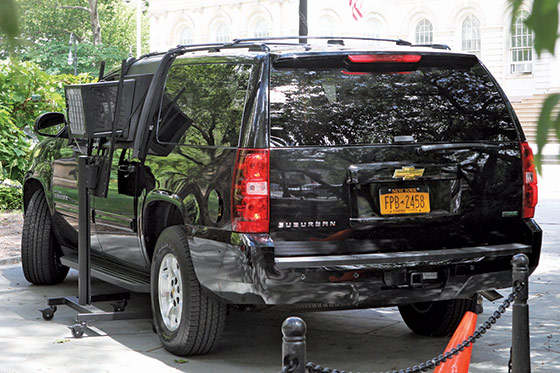
Is air-conditioning a luxury good? You’d think it wasn’t, not anymore. But last week, the New York Post splashed its front page with a photo of a residential A/C propped on a rolling stand and fitted neatly to the window of Michael Bloomberg’s SUV. It was one of those tabloid fake-outrage stories, the kind where Mayor Mike is purported to be conforming to outrageous-rich-guy type. In this one, he was requiring (suggested the Post) that his vehicle be kept comfy at all times while obeying the letter of the city’s law, which since 1971 has prohibited cars from idling at curbside for more than three minutes. Strangely, neither the Post nor the mayor’s spokesman offered a fairly reasonable explanation for this contraption: The mayor’s driver sits waiting outside City Hall for hours at a time, and if he can’t run the engine and thus the A/C, he’s going to pass out. Instead, everyone went with the rapacious-consumption-of-cold-air angle, refreshed with wisecracks about cooling off with a great big illegal Super Big Gulp.
There was a time, of course, when chilled air was truly a rarefied perk. Before the twentieth century, the very rich could arrange for contraptions to blow cold air over precious blocks of ice that had been cut from rivers during winter and stored under insulating layers of straw. Even after Willis Carrier invented the modern air conditioner, in 1902, coolness remained an expensive summertime treat for decades. It was a selling point as late as the seventies, when one of my local movie theaters still had a big sign over the doorway reading IT’S COOL INSIDE, its letters dripping with painted blue-and-white icicles. The historian Marsha Ackermann, author of Cool Comfort: America’s Romance With Air Conditioning, notes that in the thirties and forties, a chain of Texas filling stations “would pump cold compressed air into your car, and then roll up the windows really fast, and hope that you’d stay cool till the next time you stopped for gas.” In summer, this probably worked for several minutes at most.
Today, A/C is not only proletarian but, in the South and Southwest, practically essential. Places like Las Vegas simply could not exist in anything like their current form without it—so much so that the New York Times recently published an online debate about whether refrigerated air is becoming a basic right, like clean water or, say, health insurance. Yet a backlash may be on the horizon. Heating and cooling, after all, constitute a full 40 percent of New York’s residential energy consumption, and profligate use of your A/C is beginning to be perceived as a moral failing, akin to eating factory-farmed chicken or driving a Hummer.
A couple of entrepreneurs have even turned the associated guilt into an opportunity. New high-tech thermostats allow their owners, through an iPhone app or website, to control the temperature at a remove. The idea is that, instead of running your central air all day so the house is cool when you get home, you can switch it on as you leave the office, thus saving (most of) a day’s wasted energy. Like recycled plastic and Priuses, it’s a compromise measure, a technocrat’s middle-ground solution. It’s also, perhaps not coincidentally, a perfect purchase for Michael Bloomberg’s Bermuda house—if he hasn’t had one installed already.
Have good intel? Send tips to intel@nymag.com.
